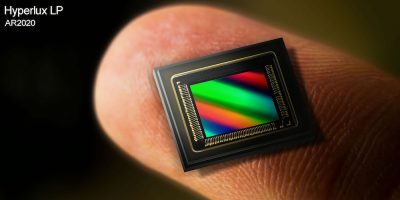Battery life in smart home and smart office devices can be extended with the Hyperlux LP image sensor, said onsemi.
They are suitable for industrial and commercial cameras such as smart doorbells, security cameras, AR / VR / XR headsets, machine vision and video conferencing. These 1.4 micron pixel sensors have low power consumption while maximising performance to capture crisp, vibrant images even in difficult lighting conditions., said the company.
Depending on the use case, customers can choose between the 5Mpixel AR0544, the 8Mpixel AR0830 or the 20Mpixel AR2020.
The stacked architecture design minimises the footprint and at its smallest approaches the size of a grain of rice, making it ideal for devices where size is critical, claimed onsemi.
The sensor can be used in home security cameras which demand high image quality, reliability and long battery life.
The image sensors can deliver clear images and more accurate object detection even in harsh weather and lighting conditions. Additionally, these cameras are often placed in locations that can be difficult to access to replace or recharge batteries, making low power consumption a critical feature.
To optimise performance, the sensors incorporate a wake on motion feature which enables them to operate in a low power mode that draws a fraction of the power needed in the full performance mode. Once the sensor detects movement, it moves to a higher performance state in less time than it takes to snap a photo.
Another feature is smart region of interest (ROI) delivering more than one ROI to give a context view of the scene at reduced bandwidth and a separate ROI in original detail.
The near-infrared (NIR) performance delivers superior image quality, said onsemi, due to the silicon design and pixel architecture, with minimal supplemental lighting.
It also reduces thermal noise and eliminates the need for heat sinks, reducing the overall cost of the vision system.
In addition to smart home devices, the Hyperlux LP family can be used in video conferencing systems.
The Hyperlux LP image sensor family will be available in Q1 2023.
Latest News
Low capacitance ESD protection diodes minimise impact on signal integrity
Nexperia has expanded its portfolio of low capacitance ESD protection diodes for high speed data lines. All variants are in leadless packages to improve electrical performance and signal integrity while enabling miniaturisation in automotive designs.
The PESD18VF1BLS-Q, PESD24VF1BLS-Q, PESD30VF1BLS-Q and PESD32VF1BLS-Q are supplied in DFN1006BD-2 packages for optical inspection in automotive production lines using side wettable flanks and the PESD18VF1BBL-Q, PESD24VF1BBL-Q and PESD30VF1BBL-Q are available in the compact DFN1006-2 package.
Target applications are in interfaces such as USB, HDMI, high-speed video links and Ethernet in automotive infotainment applications. Adding additional components to a high-speed data line can deteriorate the signal integrity of the transferred data. Therefore, choosing the right components that protect the system but do not hamper the signal transmission is vital to modern high-speed automotive systems, explained Nexperia. The signal integrity performance of the diodes is enabled by the low device capacitance (as low as a typical 0.28 pF) combined with the higher standoff voltage of 18 to 32V for placement closer to the connector. For maximum design flexibility, these diodes are offered both with and without side wettable flanks, with the side wettable flanks enabling automated optical inspection (AOI).
These AEC-Q101 automotive-qualified devices exhibit extremely deep snapback behaviour combined with a low dynamic resistance of 0.8 Ohm for improved system-level robustness and clamping performance in high-speed data interfaces.
Headquartered in the Netherlands, Nexperia is a global semiconductor company with employees across Europe, Asia, and the United States. It says it develops and produces essential semiconductors which enable the basic functionality of virtually every electronic design in the world from automotive and industrial to mobile and consumer applications.
The company has an extensive IP portfolio and certification to IATF 16949, ISO 9001, ISO 14001 and ISO 45001 standards.
Functionally safe positioning hardware-software model minimises time to market
Pre-certified to ISO-26262/ASIL-B, u-safe is end-to-end positioning hardware-software by u-blox and based on market-proven safe components which have been extensively tested in autonomous driving conditions, said u-blox. It can be seamlessly integrated into future-proof advanced driver assistance systems (ADAS) architectures, which “significantly” minimising time to market, said the company.
The model for vehicle positioning is designed to accelerate the adoption of autonomous vehicles. It uses components that are proven in automotive driver navigation systems to offer Tier 1 suppliers and OEMs driver automated and assistance systems in, for example, ADAS Level 3 and above applications requiring high integrity and functional safety features. In addition, ADAS Level 2+ applications can also benefit from u-safe, said u-blox, to ensure that these systems are future proof and ready for a transition into higher levels of automation.
u-blox claimed to be the only supplier in the market today to offer a functional-safety-and-SOTIF compliant safe end-to-end positioning solution combining proprietary hardware with customised software and correction service. The company said u-safe is simplifying the automotive supply chain for customers working on ADAS up to SAE Level 5.
Integrated into ADAS and autonomous driving stacks, u-safe represents an additional layer of safety by offering functional safety (ISO-26262 standard), high integrity and trustworthy positioning for automated and autonomous driving markets.
u-blox said u-safe ensures ASIL-B GNSS localisation for sophisticated safe automotive systems. It incorporates u-blox’s ninth generation GNSS technology platform with A9 ASIL-B chipset and module, PointSafe which uses GMV’s high accuracy and safe correction service and on-board safe position engine, the u-blox Thingstream IoT platform, as well as customised integration support.
u-safe follows the recently announced partnership with GMV, which specialises in navigation for connected and autonomous vehicles. u-blox and GMV joined forces to pioneer functional safety with market-proven components to bring functional safe E2E positioning solutions to the automotive industry for mass-market applications.
u-blox operates in positioning and wireless communication in automotive, industrial, and consumer markets. The company has a broad portfolio of chips, modules, and secure data services and connectivity. The company headquarters are in Thalwil, Switzerland, with offices in Europe, Asia, and the USA.
http://www.u-blox.com
NXP opens up S32K3 automotive microcontrollers to AWS cloud services
NXP Semiconductor has integrated Amazon Web Services (AWS) into its S32K3 automotive microcontroller series for body, zone control, and electrification applications.
The S32K3, S32Z/E, S32G2 and S32G3 enable new in-vehicle and secure cloud services. Using FreeRTOS libraries supporting AWS IoT Core, NXP’s S32K3 with integrated cloud connectivity speeds up the development time for software-defined vehicles (SDVs) to securely connect to the cloud and deliver vehicle data-driven insights and services and over-the-air (OTA) updates, claimed NXP. The software libraries also enable seamless connectivity between the S32K3 and devices running AWS IoT Greengrass.
AWS IoT services have been integrated with NXP’s S32G vehicle network processor for service-oriented gateways since 2020. The NXP S32 devices’ software with AWS cloud solution supports a range of communication technologies and can be used with wireless connectivity technologies like 4G/5G cellular and Wi-Fi. Now NXP S32K3 devices can connect directly to AWS cloud services or a more powerful S32G device using AWS cloud services such as AWS IoT Core, AWS IoT Greengrass or AWS IoT FleetWise.
Extending AWS connectivity to S32K3 gives automotive OEMs the flexibility to build AWS cloud connectivity into their vehicles regardless of the vehicle architecture used and supports the vehicle architecture transition. This includes architectures in which the S32K3 acts primarily as an end node or zonal controller and supplements an S32G vehicle network processor, as well as configurations with multiple S32K devices without an S32G processor, with at least one S32K3 acting as a gateway to access AWS cloud services.
The combination of NXP’s S32 vehicle compute platform and AWS cloud connectivity is appropriate for different mobility types. For example, the direct connection of the S32K3 devices to the cloud is suitable for smaller vehicles such as electric bicycles and scooters, where the S32K3 acts as the aggregator or main controller.
The NXP S32K3 devices are scalable, low power Arm Cortex-M series-based microcontrollers that are AEC-Q100 qualified with advanced safety and security and software support for automotive and industrial ASIL B/D applications in body, zone control and electrification. There is a dedicated hardware security engine (HSE) and A/B swap capability and OTA firmware updates to the S32K3 are secure and protected, said NXP. The devices are supported by a minimum of 15 years of product longevity and a comprehensive, third-party software and tools ecosystem.
Access to and processing of real time, vehicle wide data with secure access to cloud services and machine learning can enable intelligent vehicles that continually improve with OTA updates. This can provide insights into vehicle performance and health, driver behaviour and traffic patterns for automotive manufacturers while consumers can extend the longevity of their vehicles and add features. NXP suggested one example could be that data collected and analysed can lead to new revenue streams with services such as usage-based insurance.
About Smart Cities
This news story is brought to you by smartcitieselectronics.com, the specialist site dedicated to delivering information about what’s new in the Smart City Electronics industry, with daily news updates, new products and industry news. To stay up-to-date, register to receive our weekly newsletters and keep yourself informed on the latest technology news and new products from around the globe. Simply click this link to register here: Smart Cities Registration






